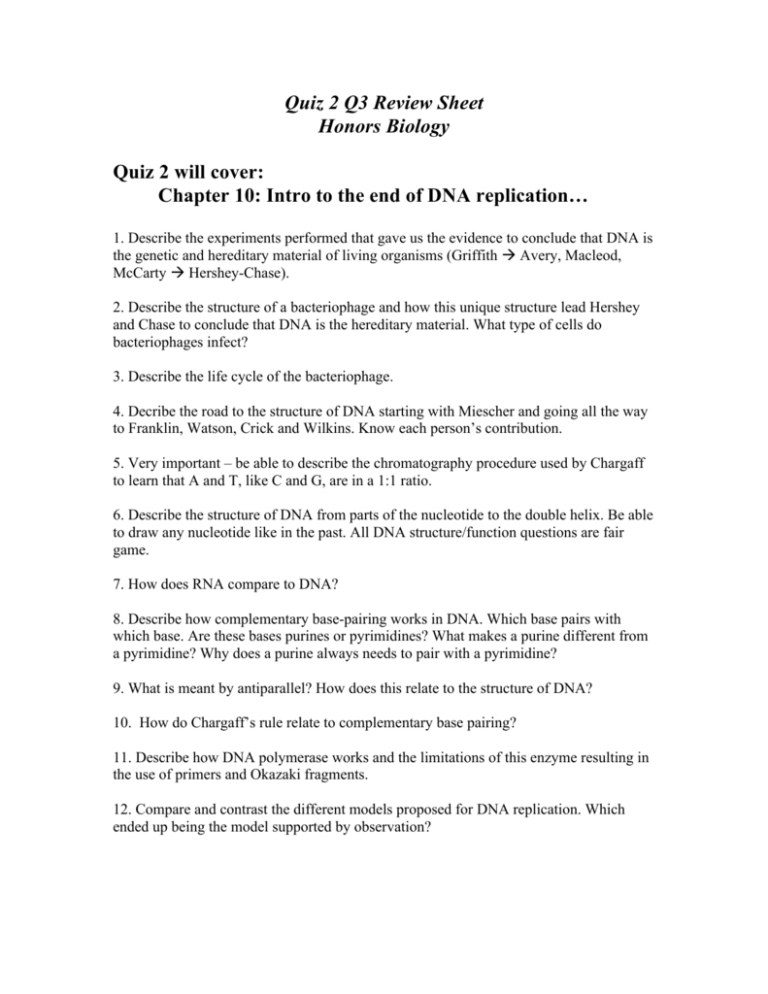Quiz 2 Q3 Review Sheet Honors Biology Quiz 2 will cover: Chapter
advertisement

Quiz 2 Q3 Review Sheet Honors Biology Quiz 2 will cover: Chapter 10: Intro to the end of DNA replication… 1. Describe the experiments performed that gave us the evidence to conclude that DNA is the genetic and hereditary material of living organisms (Griffith Avery, Macleod, McCarty Hershey-Chase). 2. Describe the structure of a bacteriophage and how this unique structure lead Hershey and Chase to conclude that DNA is the hereditary material. What type of cells do bacteriophages infect? 3. Describe the life cycle of the bacteriophage. 4. Decribe the road to the structure of DNA starting with Miescher and going all the way to Franklin, Watson, Crick and Wilkins. Know each person’s contribution. 5. Very important – be able to describe the chromatography procedure used by Chargaff to learn that A and T, like C and G, are in a 1:1 ratio. 6. Describe the structure of DNA from parts of the nucleotide to the double helix. Be able to draw any nucleotide like in the past. All DNA structure/function questions are fair game. 7. How does RNA compare to DNA? 8. Describe how complementary base-pairing works in DNA. Which base pairs with which base. Are these bases purines or pyrimidines? What makes a purine different from a pyrimidine? Why does a purine always needs to pair with a pyrimidine? 9. What is meant by antiparallel? How does this relate to the structure of DNA? 10. How do Chargaff’s rule relate to complementary base pairing? 11. Describe how DNA polymerase works and the limitations of this enzyme resulting in the use of primers and Okazaki fragments. 12. Compare and contrast the different models proposed for DNA replication. Which ended up being the model supported by observation? 13. “ESSAY QUESTION” - You need to be able to explain how DNA is replicated. This will need to be put into words starting at a single origin of replication as well as drawn. In your writing you must discuss the flow of energy and where each enzyme gets its ability to move around (accelerate) and do its work. The drawing should be a replication bubble, but you only need to put the details on one fork (look at slide 139) as the other is doing the same in the opposite direction. These words MUST be used in the writing and in the picture: origin of replication, DNA helicase, DNA ligase, RNA primase, Okazaki fragments, single-stranded binding proteins, leading strand, lagging strand, 5’, 3’, topoisomerase (gyrase), ATP, GTP, CTP, TTP, template strand, complementary strand, daughter strand, parent strand, RNA primer, DNA polymerase, 14. Look at slide 134. Make sure you understand why at a replication bubble, the top strand is the leading strand in one fork and the lagging strand in the other, and vice versa for the bottom strand. 10. Why do our chromosomes have multiple origins of replication? 11. When is DNA replication performed in a cell? 12. How often does DNA polymerase make a “mistake” and why did I put the word “mistake” in parenthesis?






